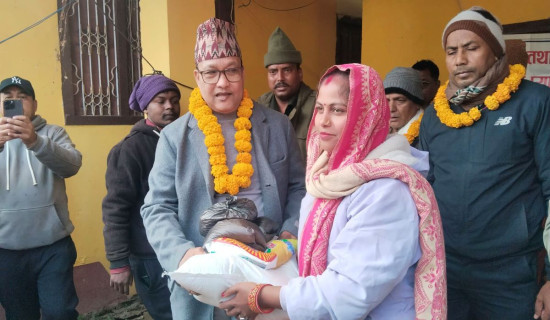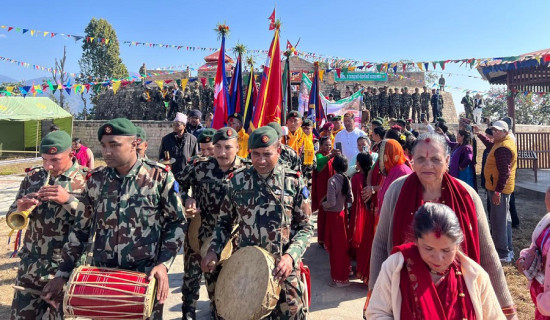- Thursday, 8 January 2026
Consensus Culture Key To Stability
With the election of President and Vice President, the second election cycle under the new constitution has come to a conclusion. The election of the head and deputy-head of the state was the last leg of the polls, which started with the local polls in May 2022. Then after, parliamentary and provincial elections were conducted in November 2022. Nepali Congress (NC) senior leader Ram Chandra Paudel and Ram Sahay Prasad Yadav of Janata Samajbadi Party got elected President and Vice President, respectively. The three major parties – NC, CPN-UML and CPN-Maoist Centre – have shared three vital posts – the President, Speaker and Prime Minister – respectively. This gives a semblance of consensus and balance in the national politics but this equation emerged only after a series of political one-upmanship involving the major and minor forces.
Unlike the 2017 polls that saw the roaring triumph of Left Alliance consisting the UML and Maoist Centre, the November 20 polls gave no majority to any party, creating a hung parliament. The November election witnessed the disunity of communist parties. The short-term political expediency took precedence over the ideological line. This also led to expunging of left-right divide, with the formation of heterogeneous alliance among the parties. Five-party alliance involving the NC, Maoist Centre, Unified Socialist, Rastriya Janamorcha and Loktantrik Samajabadi Party was pitted against the UML-led coalition that consisted of two royalist forces – Rastriya Prajatantra Party (RPP) and RPP-Nepal – in the polls.
Setback
The November poll dealt a setback to Nepali communists, thanks to the dissolution of House of Representatives (HoR) twice by former PM and UML chair KP Sharma Oli. The malign misstep split the then CPN into UML, Maoist Centre and Unified Socialist, a political bonanza for the NC that was pushed over to the margin in 2017. The rise of Rastriya Swatantra Party (RSP) and RPP exposed the people’s disenchantment with the mainstream parties. The RPP’s impressive electoral gain also indicated the anti-republican sentiments invisibly running in the populace. The NC emerged as the largest party because of the alliance as well as the division of the UML. The vertical split of the CPN drastically shrunk the UML while the Maoist Centre was virtually wiped out in the urban areas. The UML splinter Unified Socialist failed to be a national party despite winning 10 seats in the federal parliament.
However, the five-party alliance collapsed after NC president Sher Bahadur Deuba broke his promise to let Maoist Centre chair Pushpa Kamal Dahal Prachanda lead the government first. The new seven-party alliance, led by the UML, picked Prachanda as the new PM but this fragile partnership also fell apart in a matter of months like a house of cards. The RSP quit the government after it was denied the Home Ministry portfolio following the dismissal of its chair Rabi Lamichhane from the lawmaker and Home Minister over a citizenship fraud. The RPP also left the government after Prachanda forged alliance with the NC ahead of the presidential polls. The making and breaking of alliances within a span of little over two months portends that Nepali politics has a bumpy road ahead.
The presidential election has further opened the political fault lines. Owing to the backing of eight parties, it was a cakewalk for Paudel to win the presidential poll. On the other hand, the UML, stung by the desertion of all partners, tried to play its card to get its candidate elected. In the beginning, Oli opted for his loyalists for the high office. After floating several names, he endorsed the names of Subash Nembang and Asta Laxmi Shakya for the post of President and Vice President when it became obvious that they are going to be defeated by the candidates of the ruling alliance. Initially, Oli was reluctant to make Nembang as the presidential candidate although Prachanda had reportedly suggested him to pick Nembang for the post.
Analysts insist that the political scenario would have been quite different if Oli had agreed on the candidacy of Nembang in the very beginning. In fact, he was not Oli’s first choice because he had publicly refused to defend the former’s move to dissolve the parliament. Earlier, Oli also proposed Madhav Kumar Nepal, chairman of Unified Socialist, for the post as the situation was turning unfavourable for his party. Although Nepal’s name created ripples in political arena, it was a belated offer intended to divide the NC-led alliance.
Political butt
On the other hand, Shakya is considered a senior woman leader in the party after late Sahana Pradhan, and some UML insiders argue that she was subject to political butt as the party announced her candidacy for the top ceremonial job when she was sure to lose it. She was also the candidate in the first election of Vice President in 2065 BS after the country was declared republic. That time her candidacy was made inactive in the support of Madhesi Janaadhikar Party’s candidate Parmananda Jha much to her dismay. Quite the contrary, the party made Bidya Bhandari as the presidential candidate twice when her victory was certain.
The victory of 8-party alliance’s candidates in the post of President and Vice President has bolstered its position in the national politics, further cornering the UML. PM Prachanda is set to expand his cabinet after receiving the vote of confidence on March 20 Nonetheless, it is a hard nut to crack for him to handle the partners given their conflicting postures as seen in their lack of consensus on the vice presidential candidate. They require fostering the culture of consensus and spirit of collaboration so as to run the coalition government smoothly for full five-year term.
(The author is Deputy Executive Editor of this daily.)
















